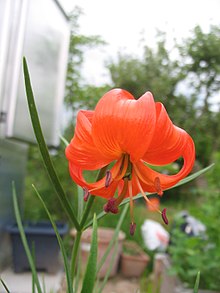| Lilium pumilum | |
|---|---|

| |
| Scientific classification | |
| Kingdom: | Plantae |
| Clade: | Tracheophytes |
| Clade: | Angiosperms |
| Clade: | Monocots |
| Order: | Liliales |
| Family: | Liliaceae |
| Subfamily: | Lilioideae |
| Tribe: | Lilieae |
| Genus: | Lilium |
| Species: | L. pumilum |
| Binomial name | |
| Lilium pumilum DC | |
| Synonyms | |
| |
Lilium pumilum is an Asian species of bulbous plants native to Mongolia, Siberia, the Russian Far East (Amur Krai, Primorye, Khabarovsk), Korea and northern China.
It is a stem-rooting bulb that grows up to 1 metre (3 ft 3 in) high, though usually rather less. The bulb itself is 4–5 inches (100–130 mm) deep and live from 2 to 4 years. The leaves are slender and grassy. It bears from one to twenty reflexed and nodding flowers, usually red in colour, and which may be spotted with black. The flowers are scented.
Named pumilum (`poo`mill`um) for its small size, compared to other lilies
It may be short lived in cultivation, but tends to last longest in well-drained soils.
In Taiwan, both the flower and bulbs are used as food, as are the other related species: L. brownii var. viridulum, L. lancifolium and L. candidum.
References
- ^ Kew World Checklist of Selected Plant Families
- Kharkevich, S.S. (ed.) (1987). Plantae Vasculares Orientalis Extremi Sovietici 2: 1-448. Nauka, Leningrad.
- Grubov, V.I. (2001). Key to the Vascular Plants of Mongolia 1: 1-411. Science Publishers, Inc. Enfield, USA. Plymouth, U.K.
- Malyschev L.I. & Peschkova , G.A. (eds.) (2001). Flora of Siberia 4: 1-238. Scientific Publishers, Inc., Enfield, Plymouth.
- "Lilium pumilum". Missouri Botanical Garden. Retrieved September 9, 2013.
- Flora of China Vol. 24 Page 145 山丹 shan dan Lilium pumilum Redouté, Liliac. 7: t. 378. 1812.
- European Garden Flora; vol. 1.
- M. Jefferson-Brown; Modern Lilies.
- "可供食品使用原料彙整一覽表". Archived from the original on 2014-01-26. Retrieved 2014-01-25.
External links
- Pacific Bulb Society Lilium Asiatic Section P-Z photos of several species
 Media related to Lilium pumilum at Wikimedia Commons
Media related to Lilium pumilum at Wikimedia Commons
This Liliales article is a stub. You can help Misplaced Pages by expanding it. |